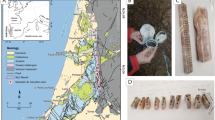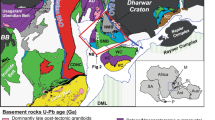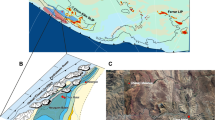Abstract
No isotope ages exceeding ∼2,800 Myr have yet been reported from Lewisian gneisses. Furthermore, there is no published isotopic evidence suggesting that Lewisian gneisses incorporate a significant proportion of much older, re-worked sialic crust. Recently, Davies1 has interpreted field evidence from small, discordant amphibolite bodies as indicating a pre-2,800-Myr history of the Lewisian Complex in the type localities of Scourie and Laxford, Sutherland, which is directly comparable with that of the Godthaab area of West Greenland. He has proposed that equivalents of the ∼3,700-Myr-old Amîtsoq gneisses and ∼2,800-Myr-old Nûk gneisses can be distinguished, on the tentative assumption that the basic bodies are the equivalents of the Ameralik dykes2–4. This paper tests this hypothesis using Pb isotopes.
This is a preview of subscription content, access via your institution
Access options
Subscribe to this journal
Receive 51 print issues and online access
$199.00 per year
only $3.90 per issue
Buy this article
- Purchase on Springer Link
- Instant access to full article PDF
Prices may be subject to local taxes which are calculated during checkout
Similar content being viewed by others
References
Davies, F. B. Nature 258, 589 (1975).
McGregor, V. R. Phil. Trans. R. Soc. A 273, 343 (1973).
Moorbath, S., O'Nions, R. K., Pankhurst, R. J., Gale, N. H. & McGregor, V. R. Nature phys. Sci. 240, 78 (1972).
Moorbath, S. & Pankhurst, R. J. Nature 262, 124 (1976).
Sutton, J. & Watson, J. Q. Jl. geol. Soc. Lond. 106, 241 (1951).
Arden, J. & Gale, N. H. Analyt. Chem. 46, 2 (1974).
Jaffey, A., Flynn, K. F., Glendenin, L. E., Bentley, W. C. & Essling, A. M. Phys. Rev. C 4, 1889 (1971).
Pidgeon, R. T. & Bowes, D. R. Geol. Mag. 109, 247 (1972).
Lyon, T. D. B., Pidgeon, R. T., Bowes, D. R. & Hopgood, A. M. J. geol. Soc. Lond. 129, 389 (1973).
Moorbath, S., Powell, J. L. & Taylor, P. N. J. geol. Soc. Lond. 131, 213 (1975).
Black, L. P., Gale, N. H., Moorbath, S., Pankhurst, R. J. & McGregor, V. R. Earth planet. Sci. Lett. 12, 245 (1971).
Moorbath, S., O'Nions, R. K. & Pankhurst, R. J. Earth planet. Sci. Lett. 27, 229 (1975).
Moorbath, S., Welke, H. & Gale, N. H. Earth planet. Sci. Lett. 6, 245 (1969).
Author information
Authors and Affiliations
Additional information
The erratum article can be found online at https://doi.org/10.1038/268466b0
Rights and permissions
About this article
Cite this article
CHAPMAN, H., MOORBATH, S. Lead isotope measurements from the oldest recognised Lewisian gneisses of north-west Scotland. Nature 268, 41–42 (1977). https://doi.org/10.1038/268041a0
Received:
Accepted:
Published:
Issue Date:
DOI: https://doi.org/10.1038/268041a0
This article is cited by
-
Archaean crustal development in the Lewisian complex of northwest Scotland
Nature (1994)
-
Polymetamorphic evolution of the Lewisian complex, NW Scotland, as recorded by U-Pb isotopic compositions of zircon, titanite and rutile
Contributions to Mineralogy and Petrology (1994)
-
Chronology and mechanism of depletion in Lewisian granulites
Contributions to Mineralogy and Petrology (1991)
-
A 1,800-million-year-old Proterozoic gneiss terrane in Islay with implications for the crustal structure and evolution of Britain
Nature (1988)
-
Granulite fades Nd-isotopic homogenization in the Lewisian complex of northwest Scotland
Nature (1988)
Comments
By submitting a comment you agree to abide by our Terms and Community Guidelines. If you find something abusive or that does not comply with our terms or guidelines please flag it as inappropriate.



